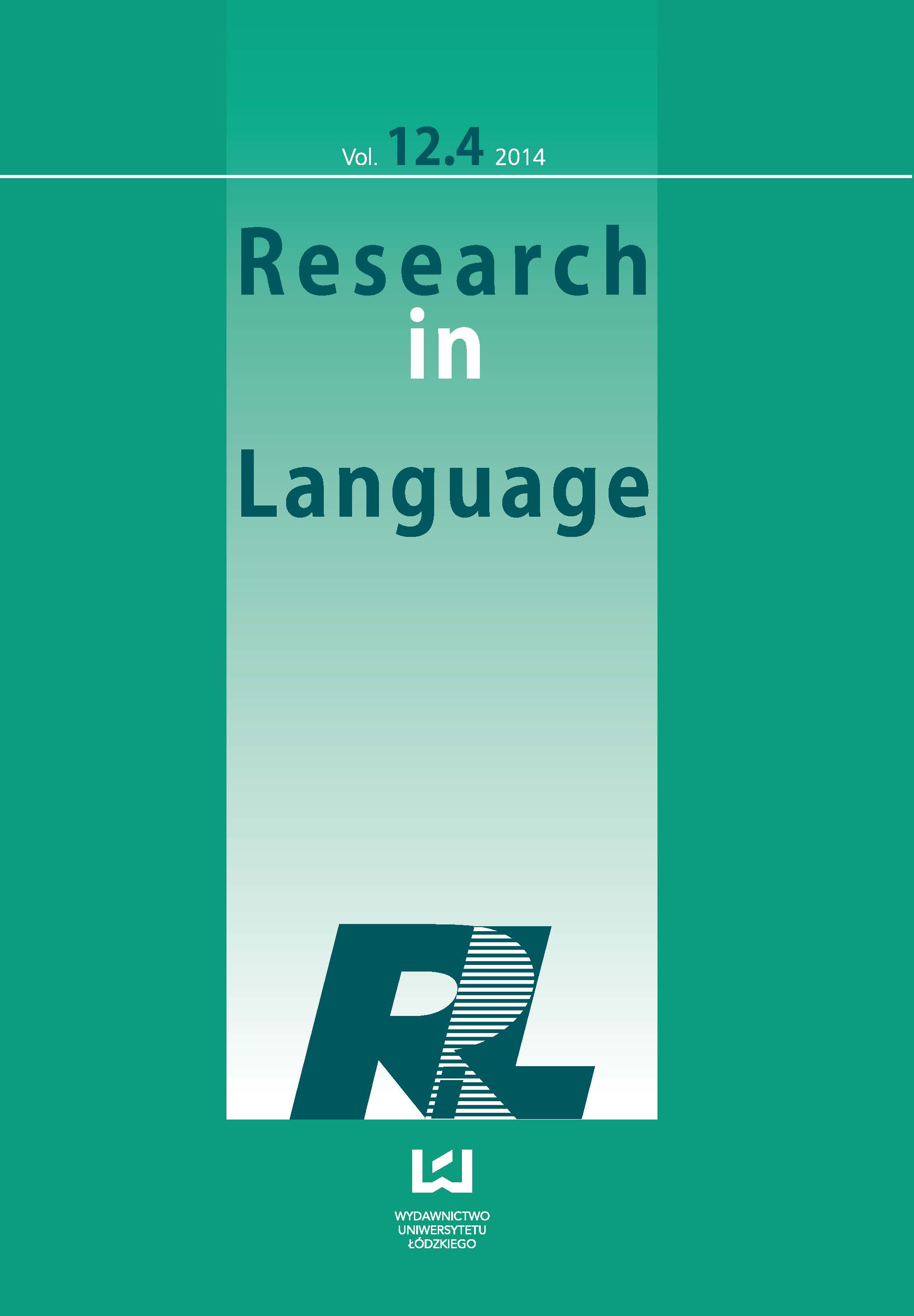Inclusion, Contrast and Polysemy in Dictionaries: The Relationship between Theory, Language Use and Lexicographic Practice
DOI:
https://doi.org/10.1515/rela-2015-0001Keywords:
semantics, lexicology, lexicography, polysemyAbstract
This paper explores the lexicographic representation of a type of polysemy that arises when the meaning of one lexical item can either include or contrast with the meaning of another, as in the case of dog/bitch, shoe/boot, finger/thumb and animal/bird. A survey of how such pairs are represented in monolingual English dictionaries showed that dictionaries mostly represent as explicitly polysemous those lexical items whose broader and narrower readings are more distinctive and clearly separable in definitional terms. They commonly only represented the broader readings for terms that are in fact frequently used in the narrower reading, as shown by data from the British National Corpus.
References
American Heritage Dictionary of the English Language, 4th edn. (2000) Boston: Houghton Mifflin.
Google Scholar
Bloomsbury English Dictionary, New Edition (2004) London: Bloomsbury.
Google Scholar
Collins English Dictionary, 9th edn. (2007) Glasgow: HarperCollins
Google Scholar
Oxford Dictionary of English, 2nd edn. revised (2005) Oxford: Oxford University Press.
Google Scholar
Collins COBUILD Advanced Dictionary, 6th edn. (2009) London: HarperCollins.
Google Scholar
Longman Dictionary of Contemporary English, 5th edn. (2009). Harlow: Longman Pearson.
Google Scholar
Oxford Advanced Learner’s Dictionary, 7th edn. (2005) Oxford: Oxford University Press.
Google Scholar
Ariel, Mira (1988). “Referring and accessibility”. Journal of Linguistics, 24(1), 65-87. DOI: 10.1017/S0022226700011567
Google Scholar
Becker, Thomas (2002). “Autohyponymy: Implicature in lexical semantics, word formation, and grammar”. Journal of Germanic Linguistics, 14(2), 105-136. DOI: 10.1017/S1470542702000065
Google Scholar
Bybee, Joan (2006). “From usage to grammar: the mind’s response to repetition”. Language, 82(4), 711-733.
Google Scholar
Church, Kenneth & Patrick Hanks (1990). “Word association norms, mutual information, and lexicography”. Computational Linguistics, 16(1), 22-29.
Google Scholar
Croft, William & D. Alan Cruse (2004). Cognitive linguistics. Cambridge: Cambridge University Press.
Google Scholar
Cruse, D. Alan (2000). “Aspects of the microstructure of word meanings”. In Y. Ravin & C. Leacock (Eds.), Polysemy: Theoretical and computational approaches (30-51). Oxford: Oxford University Press.
Google Scholar
Davies, Matt (2012). “A new approach to oppositions in discourse: The role of syntactic frames in the triggering of non-canonical oppositions”. Journal of English Linguistics, 40(1), 47-73.
Google Scholar
Davies, Mark (2004-). BYU-BNC. (Based on the British National Corpus from Oxford University Press). Available online at http://corpus.byu.edu/bnc/ DOI: 10.1177/0075424210385206
Google Scholar
Geeraerts, Dirk (1993). “Vagueness’s puzzles, polysemy’s vagaries”. Cognitive Linguistics, 4(3), 223-272. DOI: 10.1515/cogl.1993.4.3.223
Google Scholar
Geeraerts, Dirk (2001). “The definitional practice of dictionaries and the cognitive conception of polysemy”. Lexicographica, 17, 6-21. DOI: 10.1515/9783110244212.6
Google Scholar
Grice, H. Paul (1975). “Logic and conversation:. In P. Cole & J. L. Morgan (Eds.), Syntax and semantics 3 (41-58). New York: Academic Press.
Google Scholar
Haspelmath, Martin (2006). “Against markedness (and what to replace it with)”. Journal of Linguistics, 43(1), 25-70. DOI: 10.1017/S0022226705003683
Google Scholar
Hearst, Marti A. (1992). “Automatic acquisition of hyponyms from large text corpora”. Proceedings of the fourteenth international conference on computational linguistics, Nantes, France. DOI: 10.3115/992133.992154
Google Scholar
Horn, Laurence R. (1984). “Toward a new taxonomy for pragmatic inference”. In D Schiffrin (Ed.), Meaning, form, and use in context (11-42). Washington: Georgetown University Press.
Google Scholar
Huang, Yan (2009). “Neo-Gricean pragmatics and the lexicon”. International Review of Pragmatics, 1, 118-153. DOI: 10.1163/187731009X455866
Google Scholar
Ide, Nancy & Jean Véronis (1993). “Extracting knowledge bases from machine-readable dictionaries: Have we wasted our time?” Knowledge Bases & Knowledge Structures 93, Tokyo.
Google Scholar
Jones, Steven (2002). Antonymy: A corpus-based perspective. London: Routledge.
Google Scholar
Justeson, John S. & Slava M. Katz (1992) “Redefining antonymy”. Literary and Linguistic Computing, 7, 176-184. DOI: 10.1093/llc/7.3.176
Google Scholar
Kempson, Ruth M. (1980). “Ambiguity and word meaning”. In S. Greenbaum, G. Leech & J. Svartvik (Eds.), Studies in English linguistics (7-16). London: Longman.
Google Scholar
Langacker, Ronald W. (1987). Foundations of cognitive grammar (Vol. 1). Stanford: Stanford University Press.
Google Scholar
Lehrer, Adrienne (1990a). “Prototype theory and its implications for lexical analysis”. In S. L. Tsohatzidis (Ed.), Meanings and prototypes (368-381). London: Routledge.
Google Scholar
Lehrer, Adrienne (1990b). “Polysemy, conventionality, and the structure of the lexicon”. Cognitive Linguistics, 1(2), 207-246. DOI: 10.1515/cogl.1990.1.2.207
Google Scholar
Lyons, John (1977). Semantics (Vol. 1). Cambridge: Cambridge University Press.
Google Scholar
Manning, Christopher D. & Hinrich Schütze (1999). Foundations of statistical natural language processing. Cambridge, MA: MIT Press.
Google Scholar
Mettinger, Arthur (1994). Aspects of semantic opposition in English. Oxford: Clarendon Press.
Google Scholar
Mititelu, Verginica B. (2006). “Automatic extraction of patterns displaying hyponym-hypernym co-occurrence from corpora”. Proceedings of the first CESCL. Budapest, Hungary.
Google Scholar
Murphy, M. Lynne (2003). Semantic relations and the lexicon. Cambridge: Cambridge University Press.
Google Scholar
Oxford English Dictionary, 2nd ed. (1989). Oxford: Oxford University Press.
Google Scholar
Quine, Willard van Orman (1960). Word and object. Cambridge, MA: MIT Press.
Google Scholar
Rohdenburg, Günther (1985a). “Dogs, bitches and other creatures”. Journal of Semantics, 4, 117-135.
Google Scholar
Rohdenburg, Günther (1985b). “Unmarked and marked terms in English”. In G. A. J. Hoppenbrouwers, P. A. M. Seuren & A. J. M. M. Weijters (Eds.), Meaning and the lexicon (63-71). Dordrecht: Forris. DOI: 10.1093/jos/4.2.117
Google Scholar
Traugott, Elizabeth Closs & Richard B. Dasher (2002). Regularity in semantic change. Cambridge: Cambridge University Press.
Google Scholar
Tuggy, David (1993). “Ambiguity, polysemy, and vagueness”. Cognitive Linguistics, 4(3), 273-290. DOI: 10.1515/cogl.1993.4.3.273
Google Scholar
Zgusta, Ladislav (1971). Manual of lexicography. The Hague: Mouton.
Google Scholar
Zwicky, Arnold M. & Jerrold M. Sadock (1975). “Ambiguity tests and how to fail them”. In J. P. Kimball (Ed.), Syntax and semantics 4 (1-36). London: Academic Press.
Google Scholar
Downloads
Published
How to Cite
Issue
Section
License

This work is licensed under a Creative Commons Attribution-NonCommercial-NoDerivatives 4.0 International License.










